Pork butt, also known as pork shoulder, is a popular cut of meat for smoking due to its high fat and connective tissue content, which help to keep the meat juicy and flavorful when cooked low and slow. In this guide, we’ll show you how to smoke the perfect pork butt in a Weber Kettle, from preparation to cook time. Follow our tips and tricks to achieve delicious, succulent pork every time.
To smoke a pork butt in a Weber Kettle, start by setting the temperature to 250°F and arranging the charcoal using either the Snake or Minion method. Place three chunks of smoking wood on the charcoal and position the pork on the cool side of the grill. For the first 3 hours, leave the pork untouched and then start spritzing it with apple cider vinegar or apple juice every 30-40 minutes. Once the bark has formed and the internal meat temperature is close to 165°F, wrap the pork in aluminum foil and continue cooking until it reaches an internal temperature of 200°F or is probe tender. Allow the pork to rest for at least one hour before slicing or shredding.
Introduction to Smoking Pork Butt: The Benefits of Cooking Low and Slow
- The best temperature for smoking pork butt is between 220°F and 250°F, with a cook time of around 2 hours per pound.
- Any type of wood can be used for smoking pork, with chunks being preferred over chips.
- The wood can be placed on top of the fire or underneath the charcoal, with burying it providing a longer-lasting smoke.
- The Snake and Minion methods are both effective for arranging the charcoal in a Weber Kettle to maintain a consistent temperature.
- Use a leave-in meat thermometer with at least two probes to monitor the temperature of the grill and the meat.
- Trim any thick fat off the top of the pork shoulder and score the remaining fat before cooking.
- Leave the pork untouched for the first 3 hours and then spritz with apple cider vinegar or apple juice every 30-40 minutes.
- Once the bark has formed and the internal meat temperature is close to 165°F, wrap the pork in aluminum foil and continue cooking until it reaches an internal temperature of 200°F or is probe tender.
- Allow the pork to rest for at least one hour before slicing or shredding.
Setting Up Your Weber Kettle for Smoking: Tips and Techniques
| Temperature | Method | Coal | Fuel Supply | Time to Stabilize | Cook Time | Top Vent | Bottom Vent | Charcoal |
|---|---|---|---|---|---|---|---|---|
| 225-250°F | Low & Slow | 5-6 | 130 | 20-30 minutes | 10-12 hours | 1/8-1/4 open | 1/8-1/4 open | Quality Hardwood Briquettes |
When setting up your Weber Kettle, make sure you use an indirect cooking setup. Low and slow cooking involves placing the meat in the cool zone, or otherwise known as indirect cooking. This simply means that you place the meat on the grill on the opposite side of the fire. When the meat is directly above the flame, it will burn or dry out.
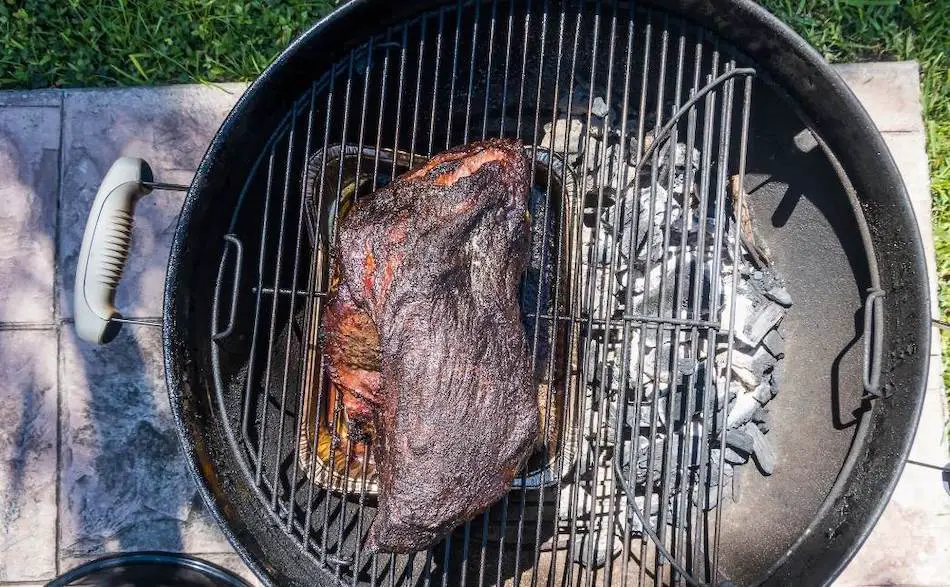
Temperature
The best temperature for smoking pork butt is between 220°F and 250°F. However, if you want the pork cooked faster, I would recommend smoking in the 275°F range because you will save yourself a lot of time. Avoid cooking above 300°F because the meat may dry out. If you cook in the lower range (200°F), it may take the whole day and half the night to cook. The cooking temperature and the size of your pork shoulder will determine the total cook time.
How Long Does It Take?
To smoke a pork butt in a Weber kettle, it should take anywhere from 7 to 15 hours depending on the size of the pork and the temperature of your Weber. A general rule of thumb is 2 hours per pound at 220°F. So a 7 pound pork butt will take about 14 hours if you hold the temperature at 220°F. I prefer to cook at 250°F because the pork is done much sooner and I don’t find it makes any difference to the final product. Pork shoulder is very resilient, because it contains a lot of fat which can keep it moist so it’s harder to dry out.
Pork Butt (shoulder) on a Weber Kettle
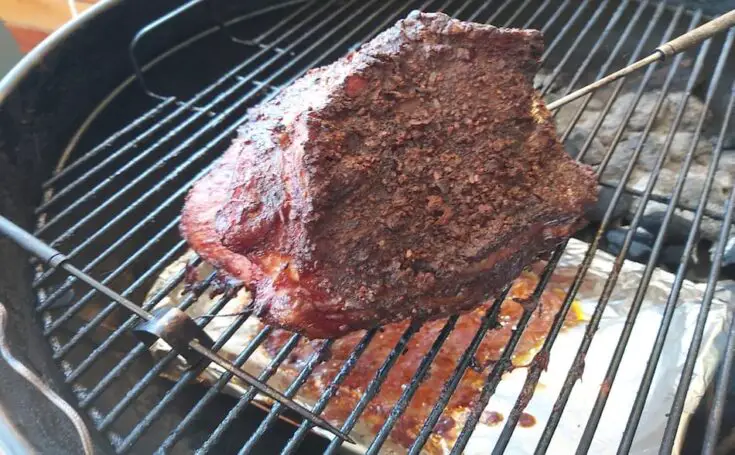
Tender, juicy pork butt smoked low-n-slow on a charcoal smoker. The perfect barbecue meat for pulled pork.
Ingredients
- Pork Butt
- Barbecue rub
- Olive oil or yellow mustard for a rub binder
Instructions
- Arrange your charcoal briquettes in either the snake method or the minion method.
- Light the charcoal and adjust the vents until your Weber Kettle stabilizes at 250°F.
- Place three chunks of smoking wood on the charcoal briquettes.
- Trim any excess fat off the pork shoulder.
- Apply and even layer of barbecue rub, or a simple course black pepper and salt seasoning.
- Place the pork but onto the grill on the opposite side to the fire, or in the cool-zone.
- Place a thermometer probe on the grill so you can track ambient temperature, and place the other thermometer probe in the port butt.
- Leave the pork butt for the first three hours and don’t open the lid to your Weber Kettle.
- After three hours, spritz the pork shoulder with apple cider vinegar or apple juice every 30 to 40 minutes.
- Once the bark is firm, and the internal meat temperature is around 165°F, remove the pork butt and wrap in aluminium foil.
- Return the pork butt to the grill, insert the thermometer probe, and cook until the internal meat temperature reaches around 200°F or is probe tender.
- Rest the pork shoulder for at least one hour before slicing or shredding.
Nutrition Information:
Serving Size:
100 gramsAmount Per Serving: Calories: 168 grams
The Best Wood For Smoking Pork Butt
Any wood will blend well with pork, so you can use either hickory, pecan, or any of the fruit woods such as apple or cherry. Chunks work best because chips will burn out too quickly. You can scatter some chips around, but you definitely need about three decent size wood chunks.
| Wood | Flavor | Description |
| Apple | Mild | Has a hint of sweetness. Safe to use on any meat, but blends particularly well with pork. |
| Cherry | Mild | Great to mix 50/50 with other woods. Adds a dark color to meat. Another wood perfect for pork. |
| Hickory | Strong | A strong smoke flavor. May overpower pork belly, so perhaps mix hickory 50/50 with a fruit wood such as apple or cherry. |
| Pecan | Moderate | A safe smoking wood that blends well with pork. Has a slight nutty flavor. Mixes well with fruit woods. |
Should You Put Wood On Top or Bottom?
There is much debate about where to place wood chunks in a charcoal fire. Most people will just throw the wood on top of the fire. However, barbeque competitors, such as Harry Soo, bury their wood underneath the charcoal because I believe it will smolder, providing a better smoke for longer.
How To Light A Weber Kettle For Pork Butt
Snake method or the minion method of arranging charcoal work best in Weber Kettles. It doesn’t really matter what method you decide to use, all that is important is that you can maintain a 250°F temperature for the entire cook.
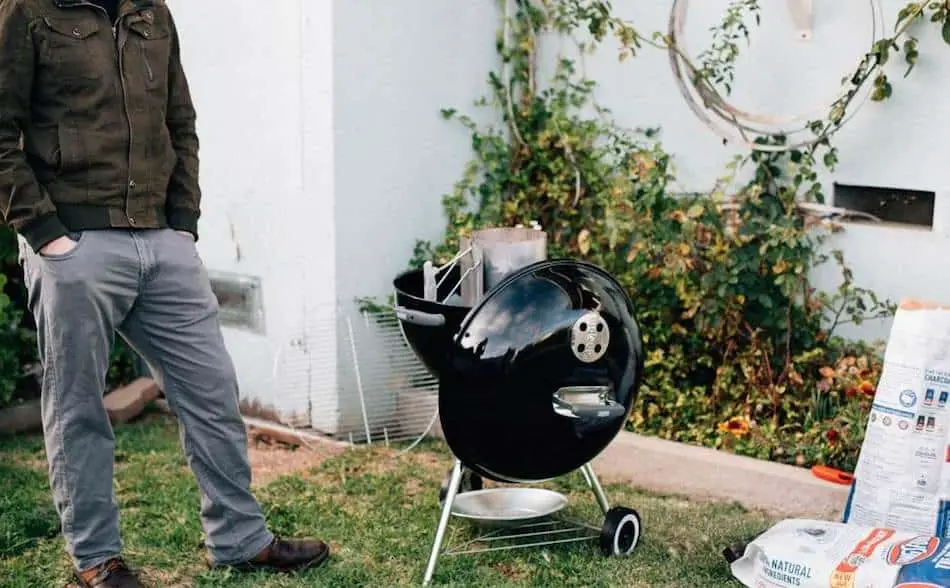
The Snake Method
The snake method involves arranging your charcoal that looks something like a snake wrapped around the outer layer of your kettle grill. You need to build your snake at least two briquettes wide with one layer of briquettes on top of the snake. Scatter the wood on top of the snake so there is a consistent flow of smoke. Light six or seven charcoal briquettes in a charcoal chimney, then place the hot coals at the head of the coal snake, then the charcoal will slowly light, one by one. If you find the temperature is not hot enough, build a thicker or longer snake.
The Minion Method
The Minion method involves piling your charcoal into the Weber Kettle, but leaving a gap in the middle, almost like a crater. Using a charcoal chimney, light about 20 briquettes and then pour the hot coals into the middle of the crater in your Weber Kettle. The fire will slowly catch through the unlit coal, providing a consistent temperature for several hours. Place wood chunks underneath the only charcoal so it slowly catches and smolders during the long cook.
How Long Does Pork Butt Take To Cook?
How To Control The Temperature
In order to control the temperature on a Weber Kettle, you will need a leave-in meat thermometer. Use a thermometer with at least two probes so you can monitor the temperature of the grill, and the temperature of the meat. You don’t need a fancy meat thermometer. I still use the TP20 on my kettle grill. It only cost me $50 and it’s one of the most popular sellers on Amazon. Check it out here.
Choosing the Right Pork Shoulder Cut and Prepping for the Smoker
When buying pork shoulder, select about with a large money muscle. This is the best tasting part of the pork shoulder and is what competitors will serve to judges in barbecue competitions. Educate yourself on the anatomy of the pork butt so when you are shopping, do you know what to look for. Also, it is better to buy a pork shoulder with the bone still intact. I will hold the meat together better and help it retain moisture to prevent it from drying out.
Trimming
Score the fat on top of the pork shoulder prior to cooking. Trim any thick fat off the top of the shoulder because it won’t render. Remove any artery fat underneath the pork shoulder because this is where the heart was attached to the animal. Never smoked pork with the skin, because it will not render and a smoke cannot penetrate the pork rind. Cook the rind and separately if you want crackling.
Should You Brine Pork Butt?
Dry brining the pork butt will add flavor and help the meat hold in moisture during the cook. To dry brine, rub kosher salt into the pork shoulder at least 2 hours prior to cooking. Even better, brine the pork the day before and leave it in the refrigerator overnight.
Injecting Pork Butt
For competition style pork, consider injecting the pork shoulder. Injecting is great for boosting the flavor of the pork, and adding extra moisture. The best injection solutions are the award-winning Butcher BBQ products. Check the last price here on Amazon. If you don’t have a meat injector, they are affordable and easy to use and you can also buy them on Amazon here.
Rub and Seasoning
The most basic way to season your pork shoulder is with a simple salt and pepper seasoning. Use a 50-50 volume, choose a nice course black pepper, and kosher salt. There are several good rubs on the market, and when I’m buying pre-made rubs, I like the use the rubs made by barbeque gurus because I know they are good. I use either Harry Soo’s Slap Yo Daddy, or Malcolm Reed’s Killer Hogs. You can’t go wrong with any of these rubs.
However, these days I prefer home-made rub recipes, and I have a generic rub that can be used on most meat. The reason I prefer to make my own is that I can control the amount of salt applied to my meat. Most store-bought rubs contain a lot of salt, which can ruin your pork if you aren’t careful. For my rub guide, check the link here.
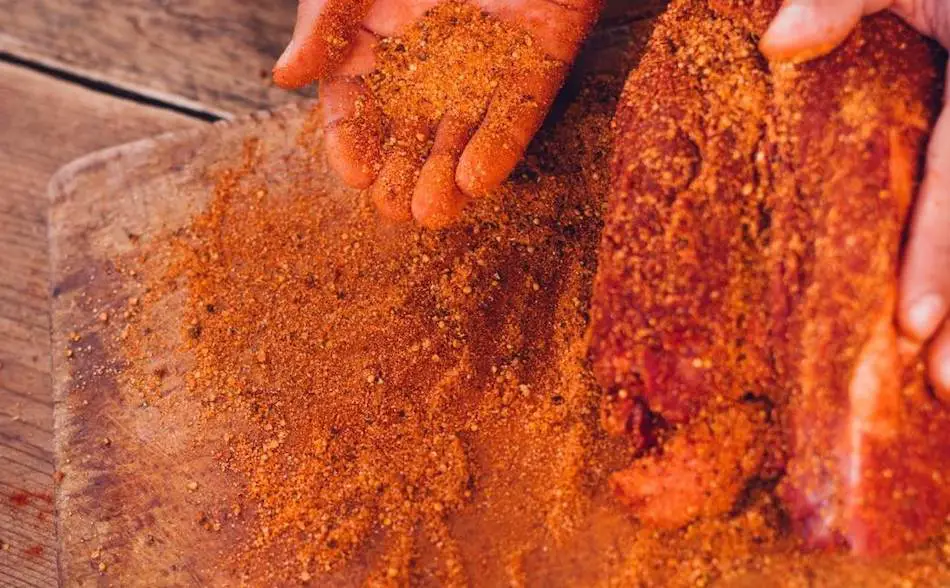
Spritzing Pork Butt
Spritzing is an important step when smoking pork butt. The last thing you want is for the edges of the meat to burn, or turn out dry. Adding some extra liquid to the meat will help the pork remain moist and prevent charring. For the first 3 hours of the cook, leave the pork butt alone. Don’t even open the lid of your Weber Kettle, just let the meat absorb the smoke and allow the temperature of your Weber to remain stable. After about 3 hours, you can spritz the meat. By this stage, the meat should have developed a nice bark and most of the fat should be half rendered. Spritz the pork but with apple cider vinegar or apple juice every 30 to 40 minutes until wrapping.
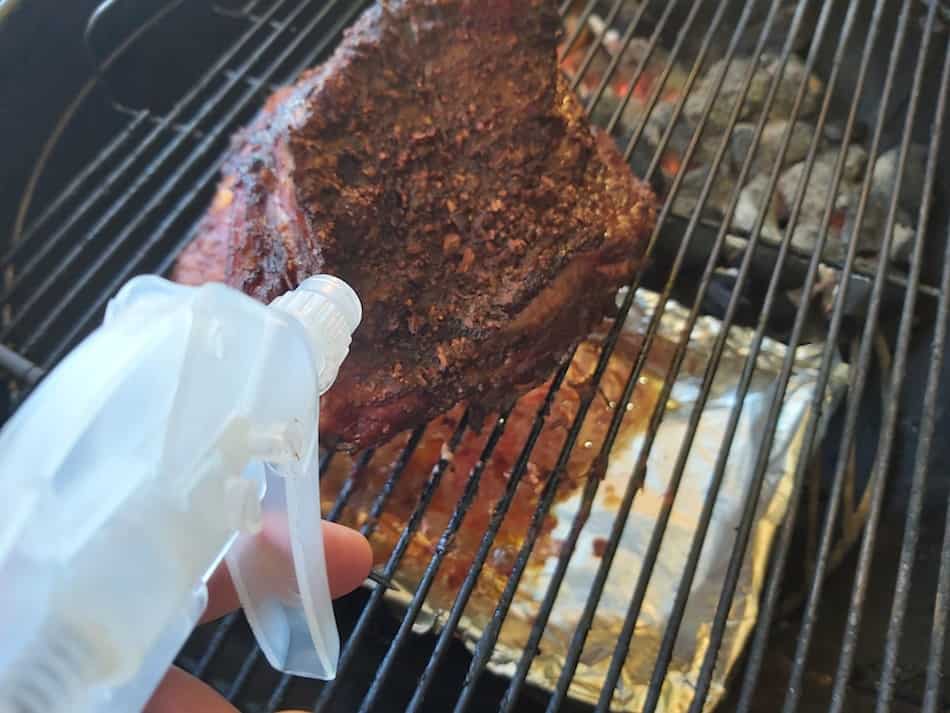
When To Spritz Pork Butt?
A big mistake many people make is spritzing too early. This will cause the rub and seasoning to wash off, leaving you with a patchy bark. I usually begin spritzing about 3 hours into the cook once the rub has fused to the meat. The best way to tell if the pork is ready for spritzing is to touch it with your finger. If the seasoning sticks to your finger, then it’s too early to spritz.
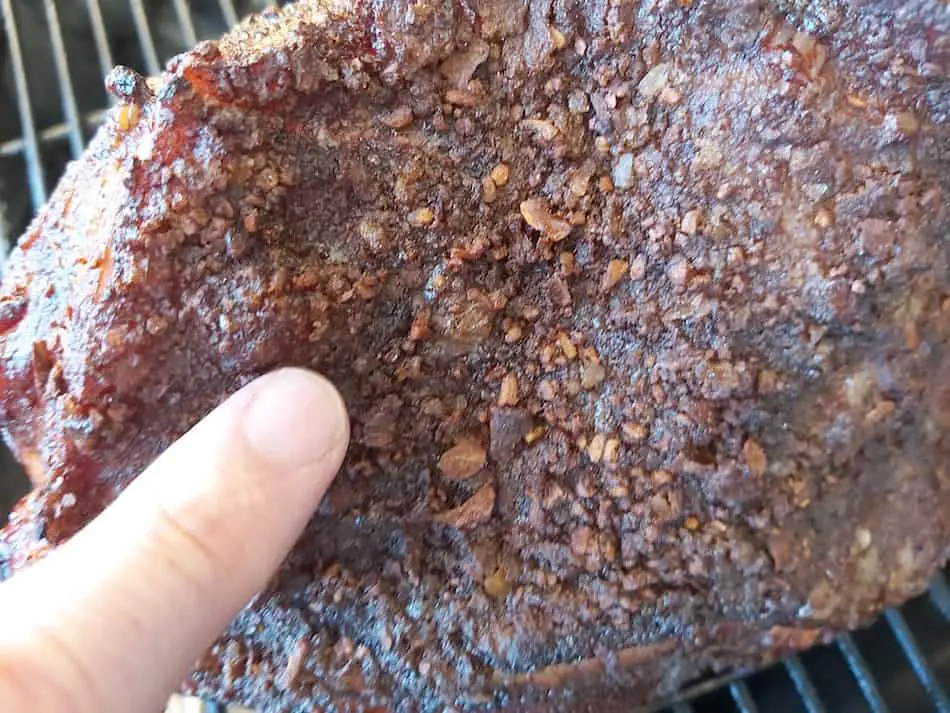
When To Wrap Pork Butt?
Wrap the pork but at around the 165°F range, which should be about five or six hours into the cook. By this stage, the pork should have developed a nice outer crust. The fat should have mostly rendered, so there is a little more to do than help the meat over the finish line without drying it out.
How To Wrap Pork Butt?
You can use either aluminium foil or butcher paper to wrap pork butt. Paper will allow the meat to breathe better, and you will end up with a crispier bark. If you don’t have butcher paper, regular aluminium foil will do the job just fine.
Take two sheets of heavy duty aluminium foil and lay them out, then place the pork butt on the aluminium foil. You can give the pork a spritz of apple cider vinegar or apple juice before closing it up, or you can just leave it as it is. Barbecue professionals do a variety of things at this stage, such as adding sticks of butter, sprinkling some brown sugar on top of the pork, or even adding barbecue sauce.
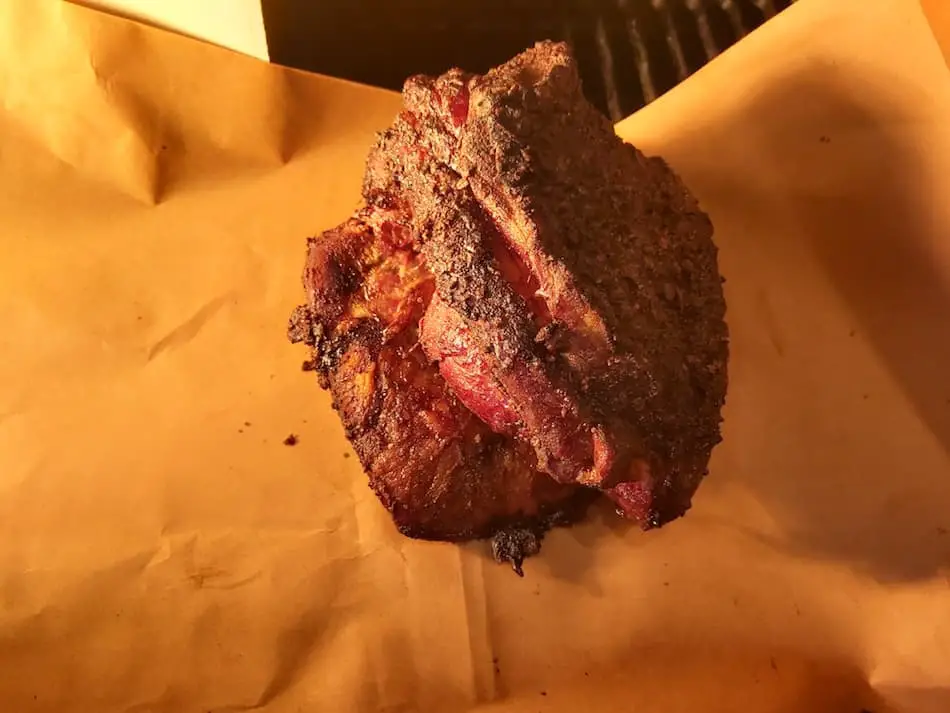
The Pork Butt Stall – And How To Beat It
The pork butt will stall anywhere between 150°F and 170°F. Once you’re happy with the color of the pork shoulder and the texture of the crust, remove it from the Weber kettle and wrap it in aluminium foil. Wrapping will help push the pork through the stall. You can also increase the temperature of your Weber Kettle by opening up the vents a little more, or adding more charcoal in the smoker. If you have a water pan, consider removing the water pan once you have wrapped the pork butt.
Use A Good Meat Thermometer
If you don’t already, get yourself a good duel-probe meat thermometer and an instant-read thermometer. Both thermometers serve a different purpose, and without these tools, it will be all guesswork. The only way to get perfect smoked meat is to know exactly what is going on inside your smoker and inside your meat. There are a lot of rubbish thermometers on the market, that are wildly in inaccurate. Do yourself a favor and buy yourself a decent thermometer so you can track your meat every step of the way. For more information, check out my Thermometer Guide here.
My Favorite Meat Smoking Tools
Thanks for checking out this article. I hope you learned a few things. Here are some of my favorite tools I use when smoking brisket that may be useful to you. These are affiliate links, so if you decide to purchase any of these products, I’ll earn a commission. But in all honesty, these are the tools I recommend to my family and friends who are just starting out.
Meat Thermometer: There are dozens of fancy thermometers on the market, but I still use my trusty TP20. For around $50, I have a high-quality meat thermometer with two probes, and can track the temperature of my smoker with one probe, and my meat with the other probe. The ThermoPro TP20 is an Amazon Best Seller because it’s the easiest thermometer to operate, is durable, highly accurate, and comes with pre-programmed meat settings.
Instant Read Thermometer: Arguably, the second most important tool you need is a fast and accurate instant-read thermometer. These tools play an important role in the latter stages of the cook when the meat needs regular checking in multiple areas. I use the ThermoPro TP19 because it can do everything a ThermaPen can do, but for a fraction of the cost. You can check out the TP19 on Amazon here.
Wireless Thermometer: The latest thermometers on the market have no wires and can be controlled by wi-fi via your phone. Airprobe 3 is the best of this technology.
Butcher Paper: Wrapping brisket in butcher paper has become a huge trend in barbeque thanks to Aaron Franklin. Wrapping your brisket in paper will give you a nice brisket bark. However, you can’t just use any old paper, it has to be unwaxed, food grade paper. You can find it on Amazon here.
Advanced Thermometer and Automatic Temperature Controller: Once you’re ready to take things seriously, the FireBoard 2 Drive is a six-channel Bluetooth/Wi-Fi thermometer that can monitor up to 6 pieces of meat, control and graph your cook sessions on your smartphone, and attaches to an an automatic blower that will convert your charcoal smoker to a set-and-forget. This is one of the most advanced meat thermometers on the market. You can check it out on the FireBoard website here.
